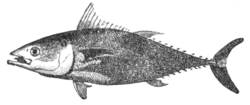1911 Encyclopædia Britannica/Tunny
TUNNY (Thunnus thynnus), one of the largest fishes of the family of mackerels, belongs to the genus of which the bonito (Th. pelamys) and the albacores (Th. albacora, Th. alalonga, &c.) are equally well-known members. From the latter the tunny is distinguished by its much shorter pectoral fins, which reach backwards only to, or nearly to, the end of the first dorsal fin. It possesses nine short inlets behind the dorsal, and eight behind the anal fin. Its colour is dark bluish above, and greyish, tinged and spotted with silvery, below. The tunny is a pelagic fish, but periodically approaches the shore, wandering in large shoals, within well-ascertained areas along the coast. It not infrequently appears in small companies or singly in the English Channel and in the German Ocean, probably in pursuit

Tunny.
of the shoals of pilchards and herrings on which it feeds. The regularity of its appearance on certain parts of the coasts of the Mediterranean has led to the establishment of a systematic fishery, which has been carried on from the time of the Phoenieians to the present day. Immense numbers of tunnies were caught on the Spanish coast and in the Sea of Marmora, where, however, this industry has much declined. The Sardinian tunnies were considered to be of superior excellence. The greatest number is now caught on the north coast of Sicily, the fisheries of this island supplying most of the preserved tunny which is exported to other parts of the world. In ancient times the fish were preserved in salt, and that coming from Sardinia, which was specially esteemed by the Romans, was known as Salsamentum sardicum. At present preference is given to tunny preserved in oil. Many of the fishes, especially the smaller ones, are consumed fresh. The tunny occurs also in the Pacific and is much sought for by anglers on the coast of southern California, where tuna-fishing has become a fashionable sport; but several other species seem to take its place in the Indo-Pacific ocean. It is one of the largest fishes, attaining to a length of ten ft. and to a weight of more than a thousand pounds.
In connexion with the extremely active life of these fishes allusion should be made to the fact, first ascertained in 1839 by John (brother of Sir Humphry) Davy, that the temperature of the blood of a tunny may be considerably higher than that of the surrounding water, a discovery which disposed of the time honoured division of vertebrate animals into warm-blooded and cold-blooded.
The variations and movements of the tunny and albacores were studied with special care by King Carlos of Portugal, who published in 1899 a large illustrated memoir entitled A Pesca do atom no Algarve in 1898 (Lisbon). This memoir is accompanied by excellent figures of the different species of Thunnus and charts of their distribution in the Atlantic.